

Balsamik lance le concept "Anti-Clichés" Un an après son lancement, Balsamik, la marque de prêt-à-porter en ligne mode-morpho dédiée aux femmes de 45 ans et plus, crée le concept "Anti-Clichés" : inviter une fois par an un artiste de renom à livrer sa perception de la femme de 45 ans et plus, épanouie, pétillante et accomplie.
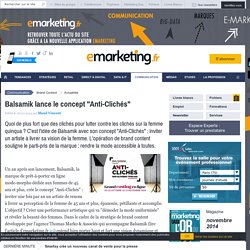
L'objectif ? Créer une performance artistique qui va "démoder la mode uniformisée" et révéler la beauté des femmes. Dans le cadre de la stratégie de brand content développée par l'agence Thomas Marko & Associés qui accompagne Balsamik (lire l'article d'emarketing.fr ici) entend bien porter haut et fort une vision dynamique et positive des femmes de 45 ans et plus et accroître, in fine, la notoriété de la marque.
Pour cette première, la marque a choisi le célèbre photographe italien Oliviero Toscani. Du casting participatif à l'exposition itinérante Concrètement, la marque a créé une application Facebook pour l'évènement : il suffit pour y participer de poster un portrait et une photo en pied. Why You Should Get Excited About Emotional Branding. Advertisement Globalization, low-cost technologies and saturated markets are making products and services interchangeable and barely distinguishable.
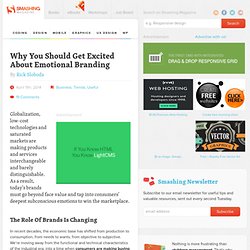
As a result, today’s brands must go beyond face value and tap into consumers’ deepest subconscious emotions to win the marketplace. The Role Of Brands Is Changing In recent decades, the economic base has shifted from production to consumption, from needs to wants, from objective to subjective. Four Key Strategies for Building Emotional Connections with your Customers - Communico Ltd. Most think that customers make buying decisions with a rational approach, analyzing details like features and financials.
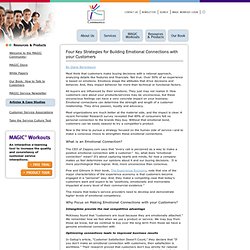
Not true. Over 50% of an experience is based on emotions. Emotions shape the attitudes that drive decisions and behavior. And, they impact behavior far more than technical or functional factors. All buyers are influenced by their emotions. Most organizations are much better at the material side, and the impact is clear. Now is the time to pursue a strategy focused on the human side of service—and to make a conscious choice to strengthen these emotional connections.
Welcome to Forbes. Cornell-brand-book. Firefox_Brand_Book. Santa brand book. Unicef branding toolkit. Foursquare-brandbook.pdf. Designing Style Guidelines For Brands And Websites. Advertisement A website is never done.
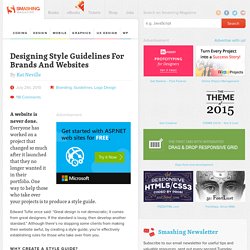
Everyone has worked on a project that changed so much after it launched that they no longer wanted it in their portfolio. One way to help those who take over your projects is to produce a style guide. Edward Tufte once said: “Great design is not democratic; it comes from great designers. If the standard is lousy, then develop another standard.” Why Create A Style Guide? You’ll have an easy guide to refer to when handing over the project.Makes you look professional.
Branding Guidelines: What To Include? Strategic Brand Overview This should be short and sweet. 1See Kew’s branding guidelines2. Kew uses strong photography in its “brand essence” message, with a few paragraphs that both inspire and define the brand. Logos For print and Web, most brands revolve around the logo. 10 magically meticulous design style guides. This is heading directly into geek territory.
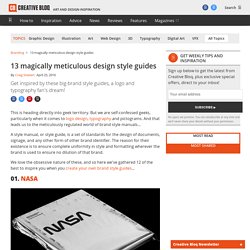
But we are self-confessed geeks, particularly when it comes to logo design, typography and pictograms. And that leads us to the meticulously regulated world of brand style manuals... A style manual, or style guide, is a set of standards for the design of documents, signage, and any other form of other brand identifier. The reason for their existence is to ensure complete uniformity in style and formatting wherever the brand is used to ensure no dilution of that brand. We love the obsessive nature of these, and so here we've gathered 12 of the best to inspire you when you create your own brand style guides...
The National Aeronautics and Space Administration's Graphics Standards Manual was created by Danne & Blackburn in 1974 when NASA changed from its original crest-based logo to the 'worm' logotype that we are now familar with. The manual has recently been revived thanks to a Kickstarter campaign to fund its reissue. Bottom Line. Systems Thinking for Breakthrough Business Performance. The headlines rolled across my feed like the credits on a blockbuster movie.

Something big seemed to be happening but I wasn’t quite sure what to make of it. It seemed that Zappos—the popular business management poster child for happy employees and customers—just announced it was adopting some new-fangled “boss-less,” “hierarchy-less,” “structure-less” management system called Holacracy. “Hola-what?” I said to myself as I started clicking links. Aimee Groth at Quartz wrote: “Zappos is going holacratic: no job titles, no managers, no hierarchy,” while the Washington Post headlined with, “Zappos Says Goodbye To Bosses,” and the Canadian Broadcast Company led with “Holacracy management style eliminates all bosses, titles.” I’ve been around long enough to know that what the media was reporting would be far removed from the truth. Each year I attend two personal/professional development workshops for my own education and growth. What Is Holacracy, Exactly? Look at it this way. How Starbucks Transformed Coffee From A Commodity Into A $4 Splurge.
Stanley Hainsworth has been a catalyst for the great brands of modern times. He was creative director at Nike and then Lego. He was vice president global creative at Starbucks in an era when the coffee purveyor was experiencing phenomenal growth. Starbucks has been hailed, acknowledged, and praised again and again for its excellence in branding and marketing, in creating a branded experience that can satisfy the connoisseur, bring in new converts, be accessible to all, and irresistible in its appeal. Think Branding, with Google - Conference Keynote - "Branding in the New Normal" Designing a Brand Identity. Skype_brandbook.pdf.